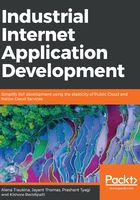
Tier 1 – IIoT machines and sensors
In a typical industrial setting, data has to be collected from industrial equipment from many different vendors, such as GE or Siemens. It is very common to see many different equipment types and protocols, such as Modbus, OPCUA, and Zigbee. A typical IIoT machine will have some inbuilt controller and processing logic that can handle the immediate processing of sensor data. In many cases, the sensor data is usually collected and processed by SCADA systems in real time and monitored by a technician, as can be seen in the following diagram:

Data gathered from this equipment is very valuable and it is sent to cloud for further upstream processing. Successful implementation of the IIoT application will require digital modeling of the equipment and its chain. This is done by asset modeling, which is essentially the creation of a digital model of the equipment along with its sensors and the sensor's data types, the unit of measures and so on. Usually this effort requires close coordination between IIoT application developers, equipment manufactures and customers to get the required appropriate information.
As a guideline, in an IIoT architecture, some data processing can occur in each of the three tiers. However, processing capabilities will be limited by the footprint to each of the IIoT tiers, for example, the processing capabilities of the devices are much smaller than the gateway. Similarly, the gateway's processing capabilities are smaller than the cloud. Hence, only basic computation can happen at the device level and, progressively, massive computation and predictive algorithms can be applied at the cloud. Data is at the heart of an IIoT architecture and, at the device level, data can be processed immediately but it lacks the depth of processing. However, at the cloud, we get the depth of insight through processing of data by applying machine learning and deep learning algorithms to gain insights. As an example for the data processing at the Edge, industrial machines use SCADA to process data in real time and provide controls to the machines. Similarly, autonomous vehicle processing happens on board the vehicle using LIDAR technology, which in turn uses AI and machine learning to help navigate the vehicle.
Further data processing at cloud is useful to gain much deeper insights and require more extensive processing. Cloud data processing involves bringing several sources of data together from many different machines/systems to predict a problem or gain insights. As an example, we can collect data from sensors from various machines in an industrial plant and do processing across these machines to gain insights to optimize the plant operations. Another example is to use historical data from sensors, and the outcomes from analytics, to provide recommendations. In this case, we would store the historical data, both the input and output action, in a cloud datastore and then use this data as a training model for supervised and unsupervised machine learning algorithms to provide recommendations for case management systems.